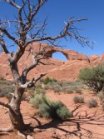
Joe's Stories from the Road
for the month of August 05
August 8
Haircut, a Drink of Water, Wild Bill, Steam Engine Train
I forgot to mention some other special things that have happened to me in the last few weeks. The Gary and Diana family in Denver, who I met long ago at Vandenberg Air Force Base, have a daughter living in Byers, Colorado. Byers is out on the plains in ranch country. Sonia Case, the daughter, runs a barbershop. She saw on the website that I had been complaining about having to have an appointment and could only get my hair styled instead of cut. So she told Diana for me to not go to a hair stylist but to come to her. So she gave me haircut like she gives to all the ranchers and cowboys around Byers and I didn’t have to have an appointment. Thanks Sonia. And I was sure impressed with your little boy mutton bustin at the local fair and rodeo. For us easterners, Mutton Bustin is when a little child rides a grown lamb like a cowboy rides a bronc. The child grabs two hands full of wool on the lamb’s back and they let her go.

"A haircut, Sonia. No styling, please."
One day I stopped in at Coyote’s Restaurant in Penrose, Colorado to eat lunch. An 18-year-old girl waited on me. On the wall above where I parked Rocinante was a thermometer that read 102 degrees. After I had eaten and was getting ready to leave, the young woman came out and gave me a cold Power drink and a cold bottle of water to take with me. She told me, “I just wanted to give this to you.” I thanked her and before leaving had her to stand by Rocinante for a photo.

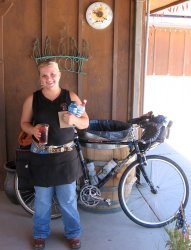
Just over 102 degrees............. Thank You for the gift of a cool drink!
A similar thing happened in Alamosa. I had two flat tires in front of a restaurant and was fixing them when I realized that I had picked up over a dozen burrs. Fixing was useless. The young woman that delivered pizzas came out and volunteered to take me and the Rocinante to a bicycle shop on down the road. She helped me load Rocinante in her pickup and drove me to Gary Tukenbrock’s bicycle shop. Thanks buddy. Your system to beat the burrs is still working. Folks, if Gary’s method works for a couple thousand miles I will share with you what he did. I have never seen this done before. We’ll see.

Joe and Al "Wild Bill Hickok" Huffman
Another meeting that I forgot to tell you about was when I met Wild Bill Hickok. Well, almost met Wild Bill Hickok. Lloyd and Carol See introduced me to their friend, Al Huffman, who has impersonated Wild Bill Hickok for going on 40 years. He dresses like Bill Hickok. Has a horse and saddles him like Bill Hickok’s horse. Al has ridden throughout the west in hundreds of parades as Wild Bill Hickok. He showed me photographs of him with President Bill Clinton and another with President Gerald Ford. He kept company with John Wayne and many other celebrities. In his bunkhouse he has an incredible collection of Wild Bill Hickok items, old posters and photographs. I really enjoyed spending an afternoon with him just visiting and talking about the man.

Steam engine
I got to do an awesome thing in Antonito, CO. I boarded the Cumbres and Toltec Scenic Railroad train. And they let me take Rocinante on board with me. The Cumbres and Toltec is a restored, narrow gauge railroad that winds its way through the Rockies 65 miles to Chama, New Mexico. During the trip we climbed to over 10,000 feet above sea level. They put Rocinante on the cattle car. After the train left the station, a lot of people went to the cattle car so they could see the plains and then the mountains pass by. On the cattle car I could not get enough of watching that black smoke bellow out of the engine up front. Every time the train would go left I would go to that side of the car so I could see the engine. The sounds of the clanging wheels under us and the choo choo of the engine when the engineer would give it more power to go up the grades was awesome. And to hear that train whistle scream when we approached a highway crossing just did something magical to your soul. After about three hours the train stopped in a little hamlet in the mountains and the three hundred passengers got off. The folks there fed us an awesome meal. Several times I walked to the front of the train so I could watch the workers fill the water tank for the steam engine. After about six hours on the train we arrived in the little town of Chama, New Mexico. The local folks and the workers at the rail yard were waving and welcoming us into Chama. I felt like I had just stepped back a hundred years into a different world. A couple of workers helped me unload Rocinante and I walked us through the crowd. It was magic and I am finding it very hard to explain this wonderful experience of riding a railroad museum on wheels. Even the soot on my face and clothes was a badge of honor. I wish every school child keeping track of the bicycle trip could have been there with me.

"Kids, let me tell you a story..."
And speaking of school
children I have to tell you that I am humbled.
I have been hearing what the teachers are doing with this
bicycle trip as it relates to their students.
I can’t thank each of you enough for the great effort that
each of you have put into this program.
I wish you could have been on that train with me, too.
I want the bicycle trip to be a great inspiration to the
children and a fun way to learn about our great country as they use
the technology that makes this exchange possible.
I want you to know that I greatly appreciate each one of you
for letting me share this with you and your students.
For all you great people
who are following this bicycle trip- you can do me a favor.
I have learned that one of the schools is keeping track of
not only my route, but of all the people who check in on the site.
Other schools will be doing this also.
If you sign the guest book on the “Where’s Joe” page, the
children will then know what town, state and country you are from.
They are maintaining a map on their school wall with pins to
represent where you folks are checking in from.
Then, they have to find your town, state and country and pin
your hometown. It’s a
great geography lesson. Thanks for helping the children.
That’s what this trip is all about.
August 22
Silverton, Sweetcorn, The Desert, Ice-cream Sandwiches
It has been over a week now since I took the
Durango Narrow Gauge Train to Silverton.
What an incredible ride.
The Cumbres and Toltec Railroad traveled across the plains
then up and over the Rockies and along the top of a magnificent
gorge and then back down into the little town of Chama, New Mexico.
The train leaves downtown Durango and goes up the Animas
River Valley and into the Canyon.
Sometimes the train inches its way around the steep cliffs
but mostly it is in the gorge.
After several hours we approached the High Mountain Town of
Silverton. The valley
opens up a bit with the snow-laden mountains looming in the
background in all directions.
When I stepped off the train it was like stepping back a
hundred years into another world. Except now it has indoor plumbing
and electricity. And, of course, the automobile.
I had made several new friends on the ride up from Durango.
They walked with me in a drizzling rain to the front of the
train to the baggage car.
There, a conductor had already unloaded Rocinante and was
holding him. Probably
wandering where the owner was.
Naturally, we had to take several photos of us and Rocinante.
I stayed the night in Silverton.
A light rain continued long after dark.
I walked the quiet streets for a while thinking about that
late afternoon when I had ridden my first Rocinante into Silverton
all those years ago. My
first bicycle was named Little DAB.
Now, like then, the dogs barked down the street and up the
street. It was almost
as I remembered it.
I’ll share a short and sad reminiscence with you
about my first trip into this area.
I had worked hard all day crossing the two huge mountain
passes coming to Silverton and I was tired.
Back then, I didn’t have the luxury of taking a hotel room.
I camped. It was
later in the year and frost would be on the ground the next morning.
I was lonesome for home folks.
I was young and away from family.
I am lonesome for home folks and family even today but was
very much more so that day.
As I rode into the empty streets of Silverton the dogs barked
from all different directions around the western town.
I ate in a little café with bare electric light bulbs hanging
from the ceiling. After
supper, I would have to find a hidden corner to lay out my sleeping
bag. But before that I
had to call home just to hear a familiar voice.
I called my cousin Peggy Bowen.
She was the only one that had a phone back then.
“Hello,” she answered.
“This is Joe. I
just had to talk to someone back home.”
It only took a minute for Peggy to ask, “Have you heard about
Uncle Jim?” “No Peggy,”
I answered, “You are the only one I ever talk to.”
Uncle Jim was our favorite uncle.
He was the one who played with us little boys and took us
places and spent money on us when he came home from Ohio where he
had a good job.“Well,”
Peggy continued, “Uncle
Jim committed suicide last week.” I began to cry as she told me the
details. Silverton has always been a sad place in my heart even
though it is a beautiful western town.
Now, as I listen to the dogs bark on that lonely street,
those memories from 38 years ago flow back into my soul.
Early the next morning, with the sun shining through the
heavy banks of fog, I found the same little coalhouse where I had
slept in all those years ago.
The next day, I pedaled across the Red Mountain
Pass. It would be one of the last big mountain passes on the trip.
I would cross a few more but that was the last one in the
Rockies. The mountain
is still very much Red.
Riding down the “million dollar highway” I became mesmerized
watching a huge helicopter lifting pipe and carrying it higher on
the mountain. I watched
him take several trips over the mountain.
It is just awesome what man is able to do.
What would Kit Carson, Lewis and Clark and all those folks
that traveled the Oregon Trail think if they could see that huge
helicopter lifting those one-ton pieces of pipe up and over Red
Mountain in just a few minutes per load?
The next stop was Ouray.
Ouray is known as the “Switzerland of America” and it is
named for the great Indian Chief Ouray of the Ute Nation.
I rode through town and stopped and talked to a couple of
tourists that I had met at the pass earlier.
Ate lunch and was on my way.
Much different than in 1967.
Back then, the local police stopped me on the edge of town
and arrested me. I was
scared. They took me to city hall.
Instead of throwing me in jail, they proclaimed me “Tourist
of the Week.”I was
given gift certificates for motel lodging, meals at local
restaurants, and gifts at gift shops.
I didn’t know this until later but David, our Project
Director for this trip, had tried for weeks to get Ouray to do the
same thing again as a surprise to me.
Well, even after many phone calls, e-mails, and sending old
newspaper articles they wouldn’t do it.
We live in a different world.
They were probably worried about getting sued.
Or maybe they thought we were gangsters trying to do in the
town. It is a little
sad but it is a different world out here today.
We are still a great country and a great people but we are
afraid of ourselves.
The next few days I rode down a valley with
flowing rivers and watched with great satisfaction a familiar site.
Here, they were raising corn.
It had already tasseled out and the silk on the corn had
turned brown. That
means, if it is sweetcorn, it’s ready to take off and put in a
boiling pot of water for tonight’s supper.
And much of the corn down in the valley around Montrose,
Delta and Grand Junction is the sweetcorn that many of us eat at our
family tables and restaurants.
The local farmers were in the harvesting mode.
And they were having the same problem that almost all farmers
have these days. They
couldn’t find enough workers to help to put in the harvest.
My next stop would be Moab, Utah.
That is a special place. I had been looking forward to
getting to Moab ever since I left Lompoc.
To get there from Fruita, Colorado, I would have to cross 91
miles of pure desert. It was
hot and there was nothing but sand, purple sage and spiraling
cliffs. 50 miles into the ride, I would reach the muddy Colorado
River. It’s a much
different river down here than the little stream I could have
stepped across in Rocky Mountain National Park.
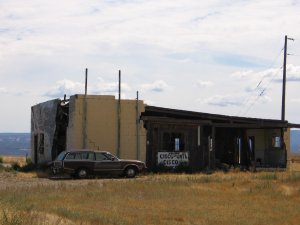
Cisco.
Just before dropping into the Colorado River Canyon I stopped again at the town of Cisco. Cisco is a collection of worn out houses and dead cars and trucks parked in the sage in every direction. The houses were really dead, too. The only place with life in 67 now had its roof caved in so I wouldn’t be able to get a cold drink there. I pulled into a street of gravel to rest and began looking around. On an outhouse was a sign that read “Out of Order.” Another store was nearby but it was locked and it really didn’t look like anyone had been around it for a long time. Faintly, I could hear what sounded like a television. I walked toward the noise to an old mobile home. I knocked on the door and a barefoot woman answered. “Could I buy a cold drink of water from you?” I asked. “Better than that,” she said, “I have pop and ice cream in the store.” I followed her back to the rundown store. She unlocked it. I ate two of the most delicious ice cream sandwiches I have ever eaten there in Cisco with the temperature approaching 100 degrees. I made it to Moab very late that afternoon. I followed the muddy river down the canyon into town.

August 24
A Couple of Firsts, Airplane Water Skiing, Interesting Folks from Switzerland, Holland
Moab, Utah. I have been waiting to get to Moab ever since I left Lompoc four and a half months ago. Two of my most memorable adventures happened with Moab people. Here, I was the first person ever to ride the Schafer Trail on a bicycle. That may not mean much to you. However, a new book listing 32 Classic Mountain Bikes Rides in the World features the Schafer Trail as the second most favorite in the world. I did it in 67 on a road bicycle- twenty years before a mountain bike was even invented. The beginning of the Trail, which is located in Canyonlands National Park, goes down a dozen switchbacks in less than one horizontal mile and drops over 2,000 feet in elevation. At the other end of the Schafer Trail is Musselman Arch. Musselman is an arch about 200 feet long and 7 feet wide at the narrowest and is about 200 feet off of the ground. In 67, I rode across it and the ride was featured in a magazine article for Western Gateways magazine. This time, my friends took me back out to the trail and I rode parts of it again. I walked my bicycle out onto the Arch. I couldn't make myself ride across. Weak knees, I guess. My excuse is that it is against the National Park Services laws and I am now an old man. It was still awesome being out there in that canyon on a bicycle again.
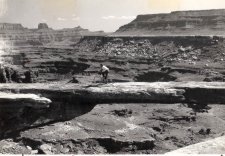
Joe riding across Musselman Arch in 1967. The first to do so- and on a Road Bike.
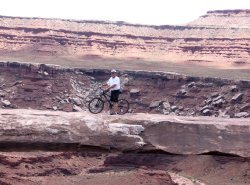
Joe -- older and wiser -- walking across Musselman Arch in 2005
The other adventure was when this crew of folks all met up at Lake Powell. There, I was their guinea pig to see if one could water-ski behind an airplane flying at 85 miles an hour. Guess what? You can ski behind a flying airplane. I did. David will fill in my description of that event that I wrote 38 years old. Terby, the friend that I stayed with in Moab, also skied behind the plane. Fran, Terby's husband, was the one that thought up the idea in the first place. He has since passed away. He was a good man and an incredible writer. He wrote over two-dozen books about the canyon country and the Native Americans who have lived there. Terby is going to share some of those books with our children. She said she would choose some that would be interesting to them. Back then, Terby also skied on my shoulders and at 82 years old was planning on doing it again when I came through but was not able to due to medical reasons. She is a great lady and an inspiration. When I grow a little older I want to be like her. Tex McClatchy, who is 79 years old and still flies his plane, told me to come back in a few years and he would pull me behind his plane again. We got into a little trouble the first time with the Bureau of Land Management and the FAA. It was a great visit in Moab again. Lot of conversation about the OLD DAYS.
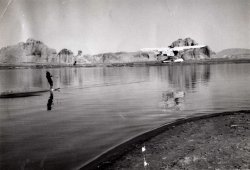
Joe water-skiing behind an airplane in '67.
In Monticello, Utah, I stopped by a small airport
and talked to a middle-aged couple who were flying all over the
southwest in an ultra-light airplane. They had been doing this for
the last four years.
They were from Switzerland.
I told them about the students in Eastern Kentucky who were
keeping up with the bicycle trip and they said that maybe next year
they would be able to come by and visit and show their films about
the Western US that they had taken from 1500 feet off the ground in
their Ultra-light Airplane.
An ultra-light airplane is basically a wing, a motor, and a
seat. You are just hanging there in the air. No cockpit. No
fuselage. Talk about a wing and a prayer…
Today, I met Arwin Vriend who is from Holland.
He is a bicyclist who thought it was great what I was doing
with Rocinante. His
profession is that he is one of the largest suppliers of bean seeds
in the world. His seeds
are grown in Holland, in the US in Washington and Idaho, Brazil and
Tanzania, Africa. He
promised that he would send some seeds to our students and explain
how his business works.
Tonight I am in Bluff, Utah, and tomorrow it is on to Mexican Hat
and then to Monument Valley.
This is where a lot of Western Movies have been made over the
years. Better go.
Sincerely, Joe
Bowen